Report: Financial Performance Analysis of Gatsby Grange (UK Hotel)
VerifiedAdded on 2023/01/10
|15
|2616
|44
Report
AI Summary
This report provides a comprehensive financial analysis of Gatsby Grange, a UK hotel, examining its financial performance through ratio analysis. The study calculates and interprets profitability ratios (gross profit, net profit, return on assets, return on capital employed), liquidity ratios (current ratio, quick ratio), and gearing ratios (debt to equity, debt ratio) for the years 2018 and 2019. The analysis highlights trends, such as declining gross and net profit margins in 2019, and assesses the company's liquidity and solvency positions. Furthermore, the report emphasizes the importance of understanding ratio analysis for informed decision-making in the hotel industry, discussing its benefits (e.g., identifying financial trends, facilitating comparisons, supporting investment decisions) and limitations (e.g., potential for manipulation, disregard for qualitative factors, seasonal business considerations). The report concludes by illustrating how ratio analysis can aid in evaluating the company's funding, expenditure, and operational decisions.

ANALYSIS OF
FINANCIAL
STATEMENT
FINANCIAL
STATEMENT
Paraphrase This Document
Need a fresh take? Get an instant paraphrase of this document with our AI Paraphraser
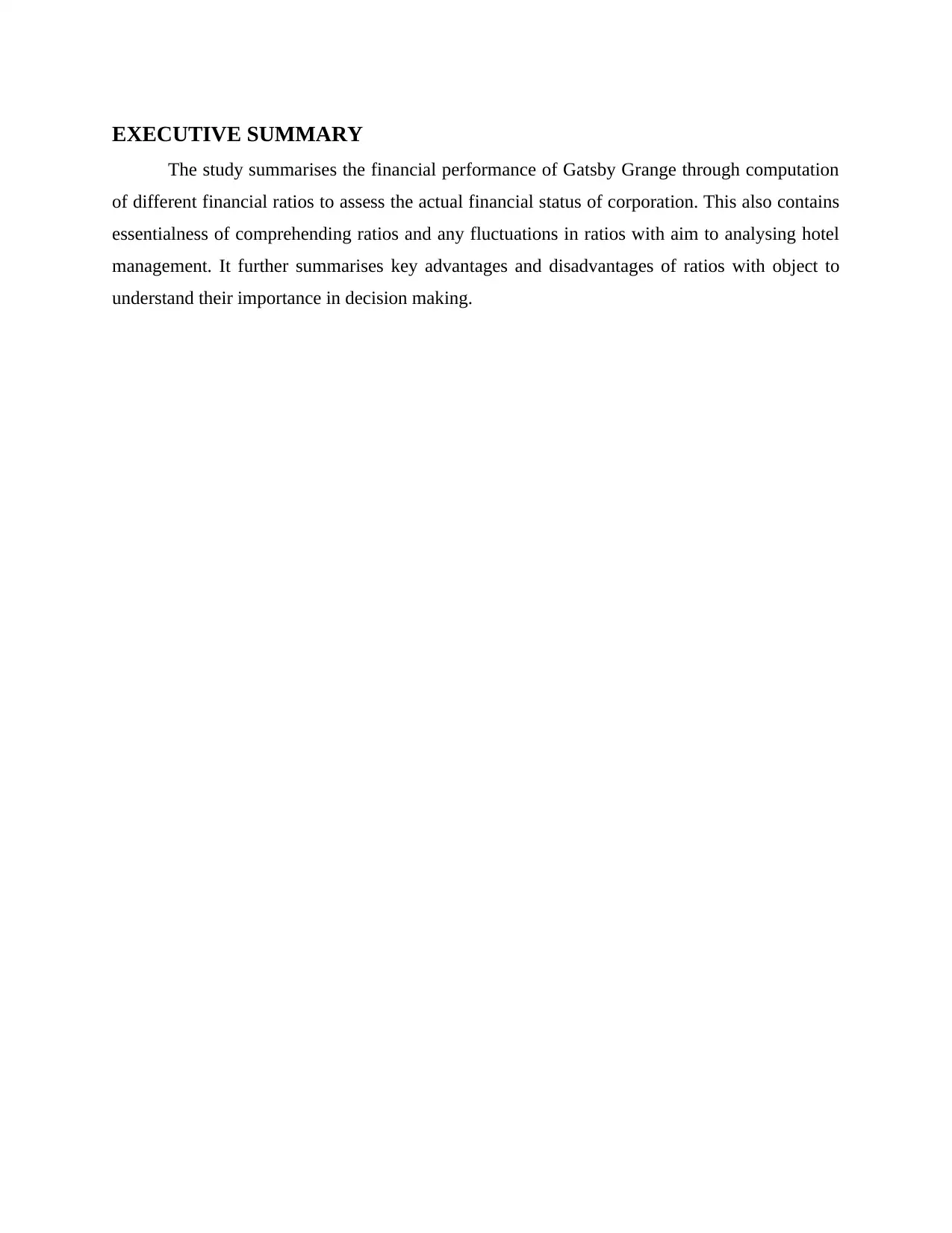
EXECUTIVE SUMMARY
The study summarises the financial performance of Gatsby Grange through computation
of different financial ratios to assess the actual financial status of corporation. This also contains
essentialness of comprehending ratios and any fluctuations in ratios with aim to analysing hotel
management. It further summarises key advantages and disadvantages of ratios with object to
understand their importance in decision making.
The study summarises the financial performance of Gatsby Grange through computation
of different financial ratios to assess the actual financial status of corporation. This also contains
essentialness of comprehending ratios and any fluctuations in ratios with aim to analysing hotel
management. It further summarises key advantages and disadvantages of ratios with object to
understand their importance in decision making.
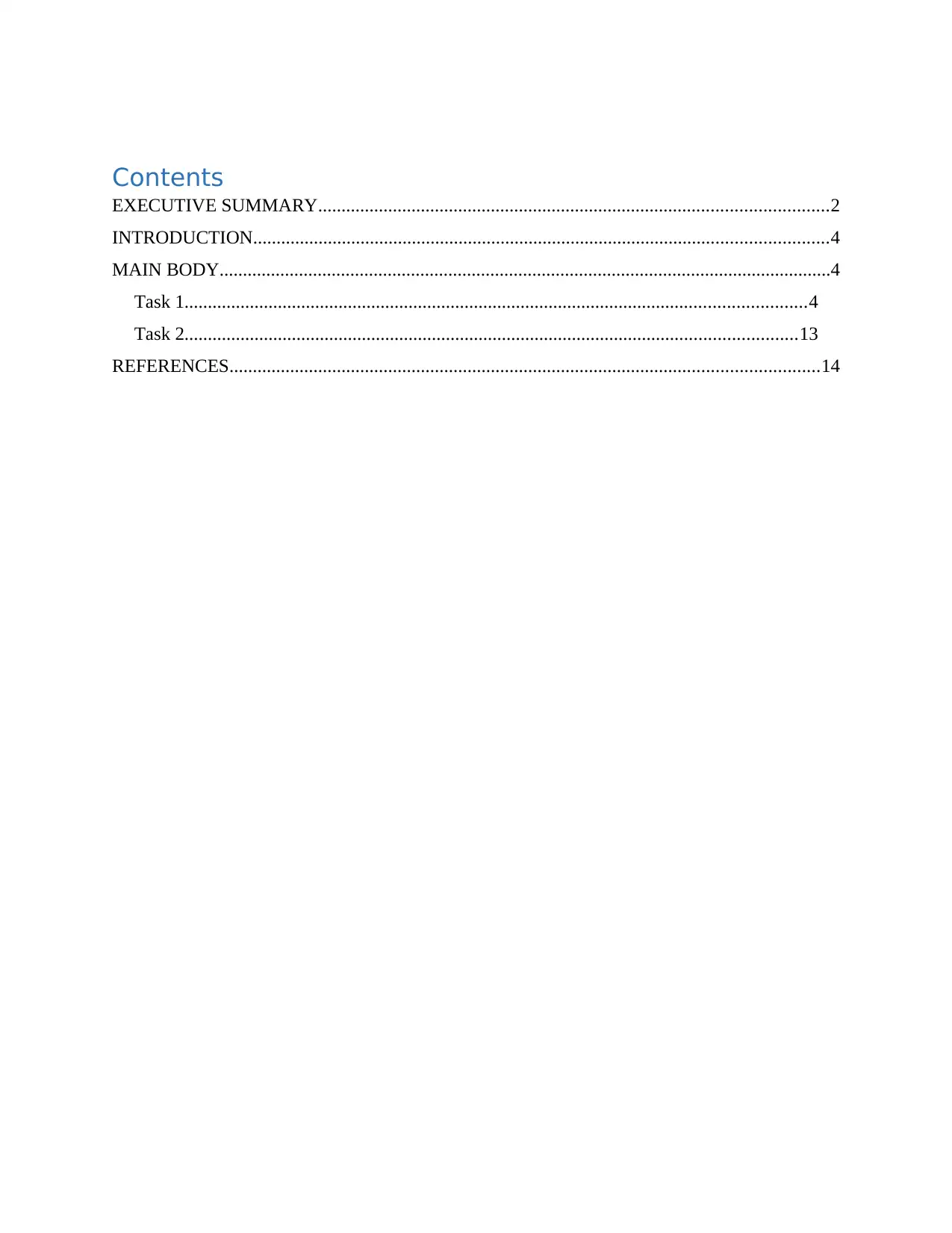
Contents
EXECUTIVE SUMMARY.............................................................................................................2
INTRODUCTION...........................................................................................................................4
MAIN BODY...................................................................................................................................4
Task 1.....................................................................................................................................4
Task 2...................................................................................................................................13
REFERENCES..............................................................................................................................14
EXECUTIVE SUMMARY.............................................................................................................2
INTRODUCTION...........................................................................................................................4
MAIN BODY...................................................................................................................................4
Task 1.....................................................................................................................................4
Task 2...................................................................................................................................13
REFERENCES..............................................................................................................................14
⊘ This is a preview!⊘
Do you want full access?
Subscribe today to unlock all pages.

Trusted by 1+ million students worldwide
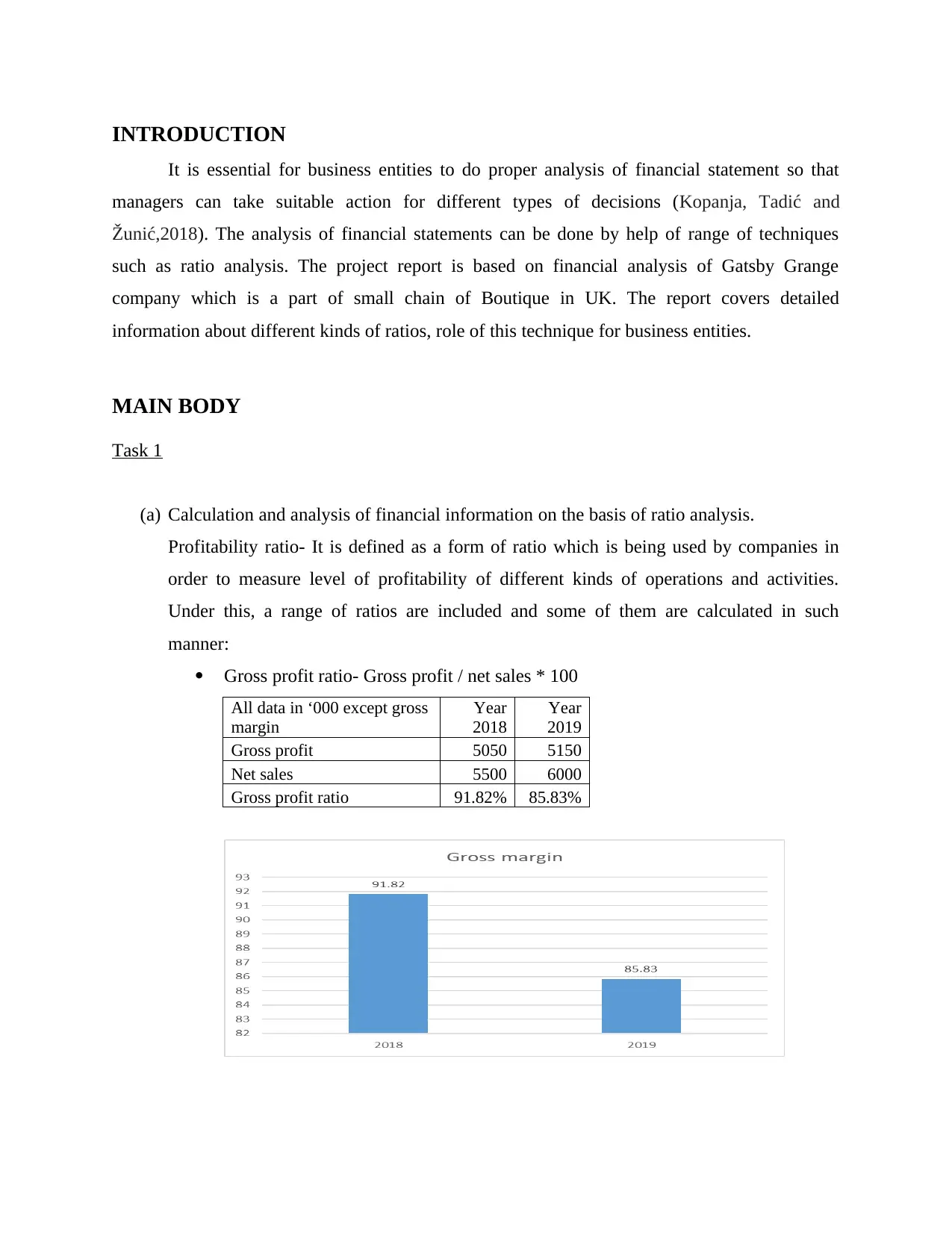
INTRODUCTION
It is essential for business entities to do proper analysis of financial statement so that
managers can take suitable action for different types of decisions (Kopanja, Tadić and
Žunić,2018). The analysis of financial statements can be done by help of range of techniques
such as ratio analysis. The project report is based on financial analysis of Gatsby Grange
company which is a part of small chain of Boutique in UK. The report covers detailed
information about different kinds of ratios, role of this technique for business entities.
MAIN BODY
Task 1
(a) Calculation and analysis of financial information on the basis of ratio analysis.
Profitability ratio- It is defined as a form of ratio which is being used by companies in
order to measure level of profitability of different kinds of operations and activities.
Under this, a range of ratios are included and some of them are calculated in such
manner:
Gross profit ratio- Gross profit / net sales * 100
All data in ‘000 except gross
margin
Year
2018
Year
2019
Gross profit 5050 5150
Net sales 5500 6000
Gross profit ratio 91.82% 85.83%
It is essential for business entities to do proper analysis of financial statement so that
managers can take suitable action for different types of decisions (Kopanja, Tadić and
Žunić,2018). The analysis of financial statements can be done by help of range of techniques
such as ratio analysis. The project report is based on financial analysis of Gatsby Grange
company which is a part of small chain of Boutique in UK. The report covers detailed
information about different kinds of ratios, role of this technique for business entities.
MAIN BODY
Task 1
(a) Calculation and analysis of financial information on the basis of ratio analysis.
Profitability ratio- It is defined as a form of ratio which is being used by companies in
order to measure level of profitability of different kinds of operations and activities.
Under this, a range of ratios are included and some of them are calculated in such
manner:
Gross profit ratio- Gross profit / net sales * 100
All data in ‘000 except gross
margin
Year
2018
Year
2019
Gross profit 5050 5150
Net sales 5500 6000
Gross profit ratio 91.82% 85.83%
Paraphrase This Document
Need a fresh take? Get an instant paraphrase of this document with our AI Paraphraser
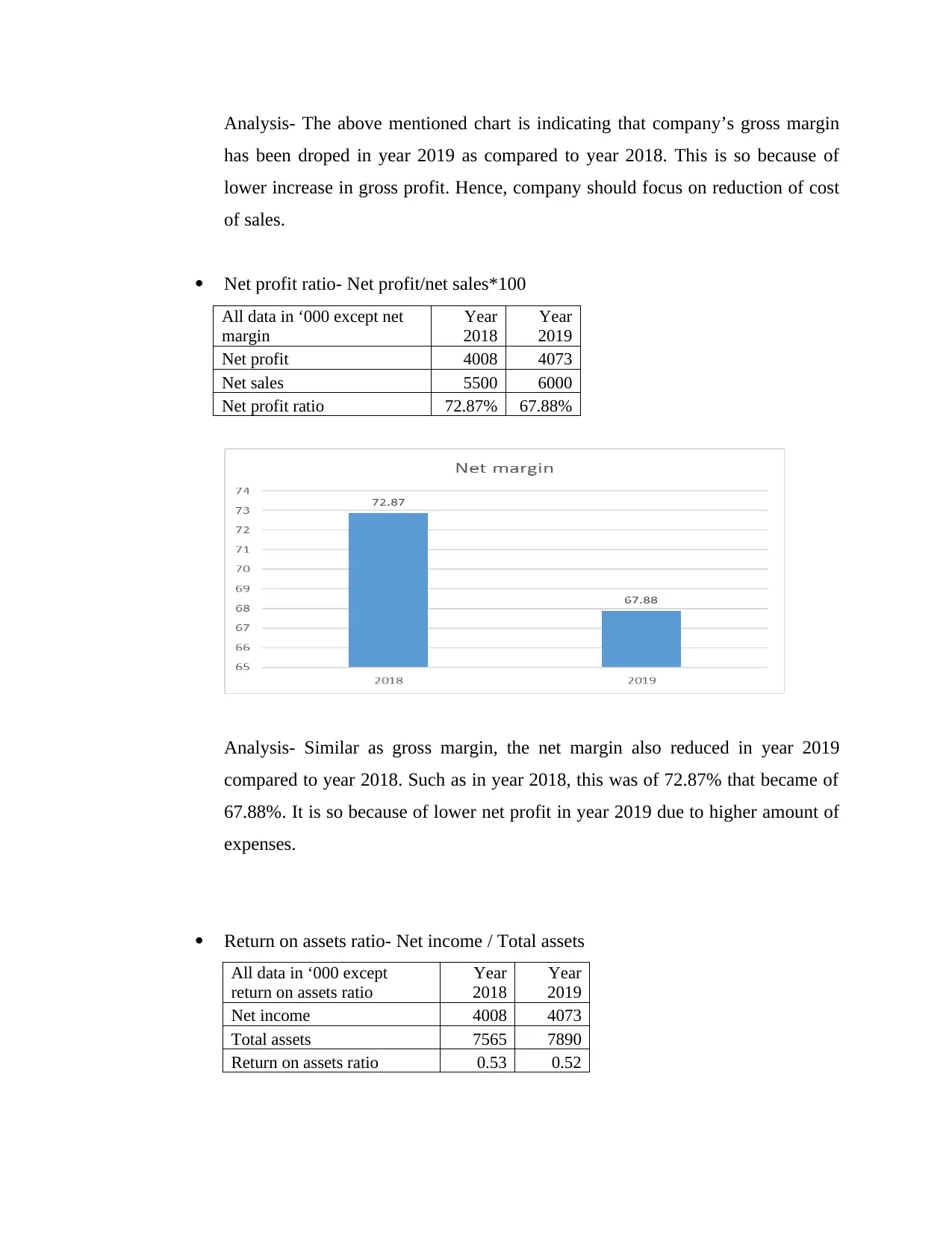
Analysis- The above mentioned chart is indicating that company’s gross margin
has been droped in year 2019 as compared to year 2018. This is so because of
lower increase in gross profit. Hence, company should focus on reduction of cost
of sales.
Net profit ratio- Net profit/net sales*100
All data in ‘000 except net
margin
Year
2018
Year
2019
Net profit 4008 4073
Net sales 5500 6000
Net profit ratio 72.87% 67.88%
Analysis- Similar as gross margin, the net margin also reduced in year 2019
compared to year 2018. Such as in year 2018, this was of 72.87% that became of
67.88%. It is so because of lower net profit in year 2019 due to higher amount of
expenses.
Return on assets ratio- Net income / Total assets
All data in ‘000 except
return on assets ratio
Year
2018
Year
2019
Net income 4008 4073
Total assets 7565 7890
Return on assets ratio 0.53 0.52
has been droped in year 2019 as compared to year 2018. This is so because of
lower increase in gross profit. Hence, company should focus on reduction of cost
of sales.
Net profit ratio- Net profit/net sales*100
All data in ‘000 except net
margin
Year
2018
Year
2019
Net profit 4008 4073
Net sales 5500 6000
Net profit ratio 72.87% 67.88%
Analysis- Similar as gross margin, the net margin also reduced in year 2019
compared to year 2018. Such as in year 2018, this was of 72.87% that became of
67.88%. It is so because of lower net profit in year 2019 due to higher amount of
expenses.
Return on assets ratio- Net income / Total assets
All data in ‘000 except
return on assets ratio
Year
2018
Year
2019
Net income 4008 4073
Total assets 7565 7890
Return on assets ratio 0.53 0.52
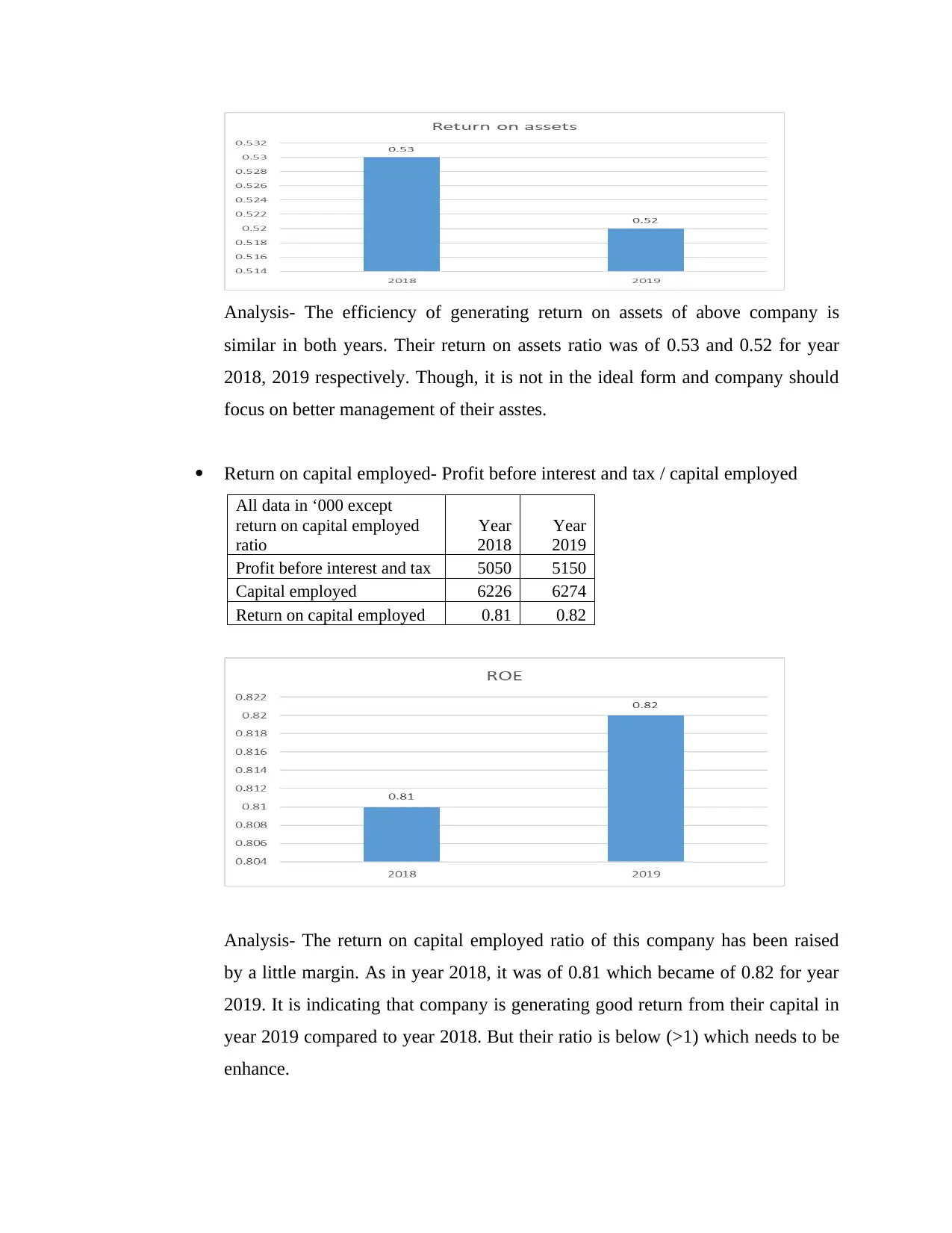
Analysis- The efficiency of generating return on assets of above company is
similar in both years. Their return on assets ratio was of 0.53 and 0.52 for year
2018, 2019 respectively. Though, it is not in the ideal form and company should
focus on better management of their asstes.
Return on capital employed- Profit before interest and tax / capital employed
All data in ‘000 except
return on capital employed
ratio
Year
2018
Year
2019
Profit before interest and tax 5050 5150
Capital employed 6226 6274
Return on capital employed 0.81 0.82
Analysis- The return on capital employed ratio of this company has been raised
by a little margin. As in year 2018, it was of 0.81 which became of 0.82 for year
2019. It is indicating that company is generating good return from their capital in
year 2019 compared to year 2018. But their ratio is below (>1) which needs to be
enhance.
similar in both years. Their return on assets ratio was of 0.53 and 0.52 for year
2018, 2019 respectively. Though, it is not in the ideal form and company should
focus on better management of their asstes.
Return on capital employed- Profit before interest and tax / capital employed
All data in ‘000 except
return on capital employed
ratio
Year
2018
Year
2019
Profit before interest and tax 5050 5150
Capital employed 6226 6274
Return on capital employed 0.81 0.82
Analysis- The return on capital employed ratio of this company has been raised
by a little margin. As in year 2018, it was of 0.81 which became of 0.82 for year
2019. It is indicating that company is generating good return from their capital in
year 2019 compared to year 2018. But their ratio is below (>1) which needs to be
enhance.
⊘ This is a preview!⊘
Do you want full access?
Subscribe today to unlock all pages.

Trusted by 1+ million students worldwide
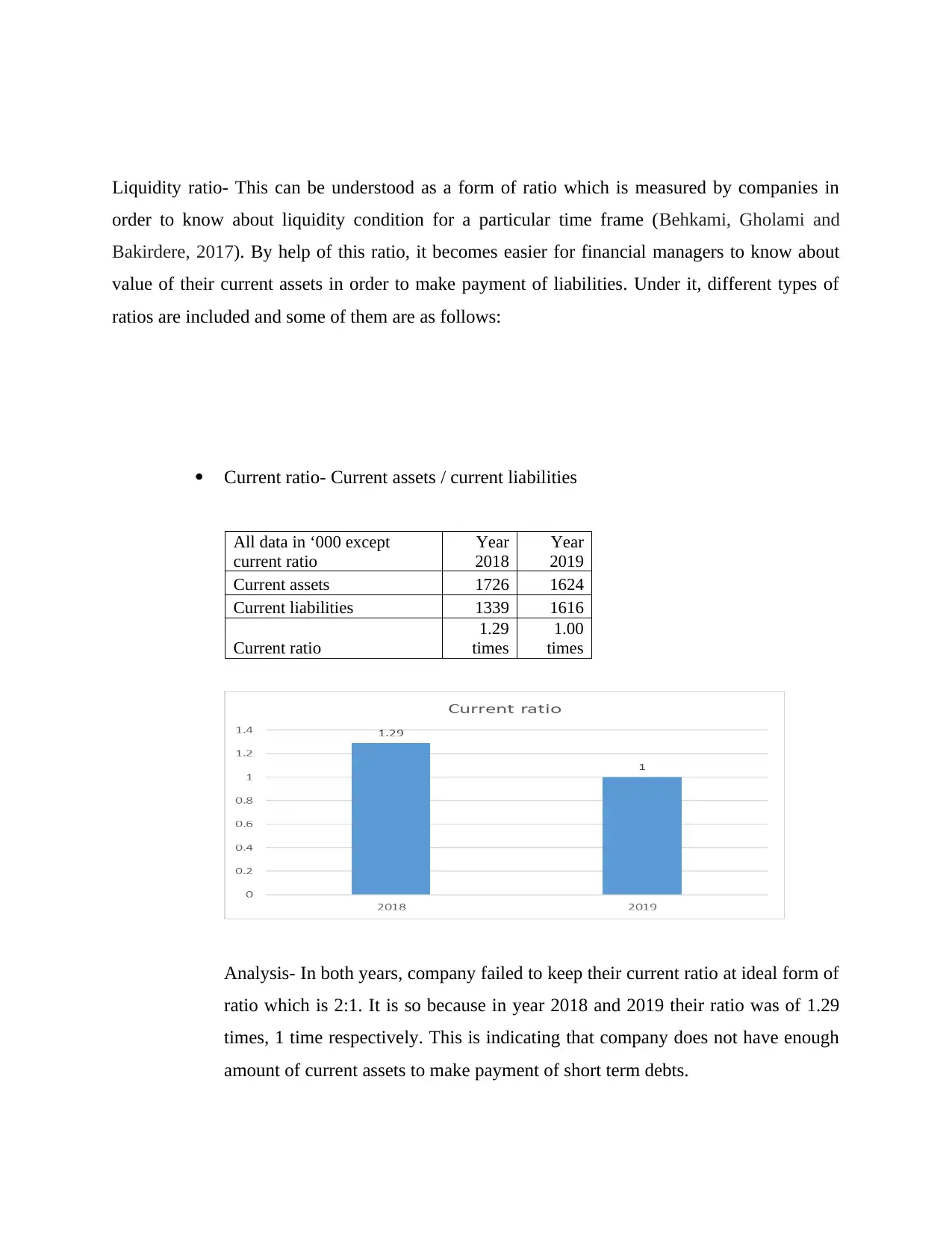
Liquidity ratio- This can be understood as a form of ratio which is measured by companies in
order to know about liquidity condition for a particular time frame (Behkami, Gholami and
Bakirdere, 2017). By help of this ratio, it becomes easier for financial managers to know about
value of their current assets in order to make payment of liabilities. Under it, different types of
ratios are included and some of them are as follows:
Current ratio- Current assets / current liabilities
All data in ‘000 except
current ratio
Year
2018
Year
2019
Current assets 1726 1624
Current liabilities 1339 1616
Current ratio
1.29
times
1.00
times
Analysis- In both years, company failed to keep their current ratio at ideal form of
ratio which is 2:1. It is so because in year 2018 and 2019 their ratio was of 1.29
times, 1 time respectively. This is indicating that company does not have enough
amount of current assets to make payment of short term debts.
order to know about liquidity condition for a particular time frame (Behkami, Gholami and
Bakirdere, 2017). By help of this ratio, it becomes easier for financial managers to know about
value of their current assets in order to make payment of liabilities. Under it, different types of
ratios are included and some of them are as follows:
Current ratio- Current assets / current liabilities
All data in ‘000 except
current ratio
Year
2018
Year
2019
Current assets 1726 1624
Current liabilities 1339 1616
Current ratio
1.29
times
1.00
times
Analysis- In both years, company failed to keep their current ratio at ideal form of
ratio which is 2:1. It is so because in year 2018 and 2019 their ratio was of 1.29
times, 1 time respectively. This is indicating that company does not have enough
amount of current assets to make payment of short term debts.
Paraphrase This Document
Need a fresh take? Get an instant paraphrase of this document with our AI Paraphraser
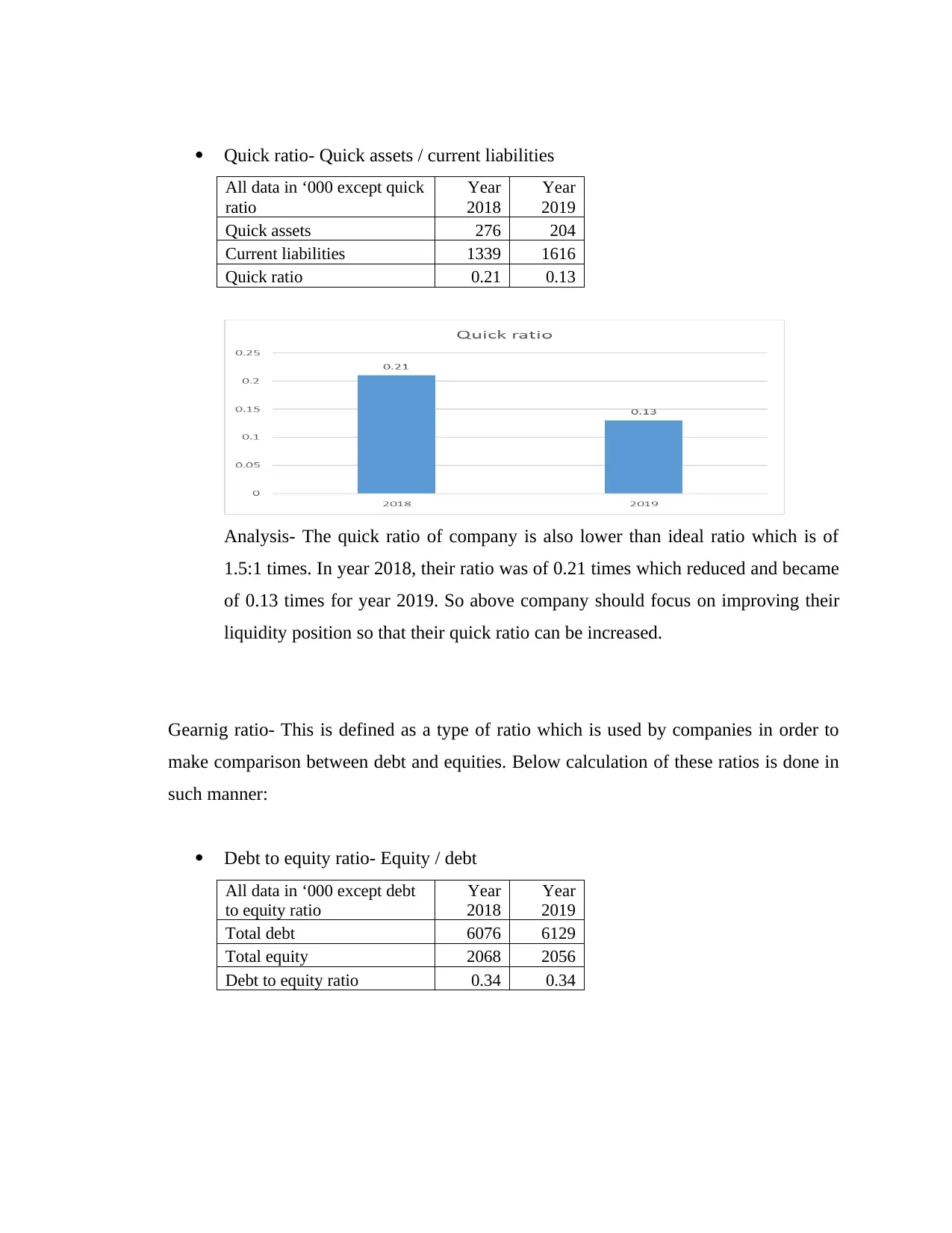
Quick ratio- Quick assets / current liabilities
All data in ‘000 except quick
ratio
Year
2018
Year
2019
Quick assets 276 204
Current liabilities 1339 1616
Quick ratio 0.21 0.13
Analysis- The quick ratio of company is also lower than ideal ratio which is of
1.5:1 times. In year 2018, their ratio was of 0.21 times which reduced and became
of 0.13 times for year 2019. So above company should focus on improving their
liquidity position so that their quick ratio can be increased.
Gearnig ratio- This is defined as a type of ratio which is used by companies in order to
make comparison between debt and equities. Below calculation of these ratios is done in
such manner:
Debt to equity ratio- Equity / debt
All data in ‘000 except debt
to equity ratio
Year
2018
Year
2019
Total debt 6076 6129
Total equity 2068 2056
Debt to equity ratio 0.34 0.34
All data in ‘000 except quick
ratio
Year
2018
Year
2019
Quick assets 276 204
Current liabilities 1339 1616
Quick ratio 0.21 0.13
Analysis- The quick ratio of company is also lower than ideal ratio which is of
1.5:1 times. In year 2018, their ratio was of 0.21 times which reduced and became
of 0.13 times for year 2019. So above company should focus on improving their
liquidity position so that their quick ratio can be increased.
Gearnig ratio- This is defined as a type of ratio which is used by companies in order to
make comparison between debt and equities. Below calculation of these ratios is done in
such manner:
Debt to equity ratio- Equity / debt
All data in ‘000 except debt
to equity ratio
Year
2018
Year
2019
Total debt 6076 6129
Total equity 2068 2056
Debt to equity ratio 0.34 0.34
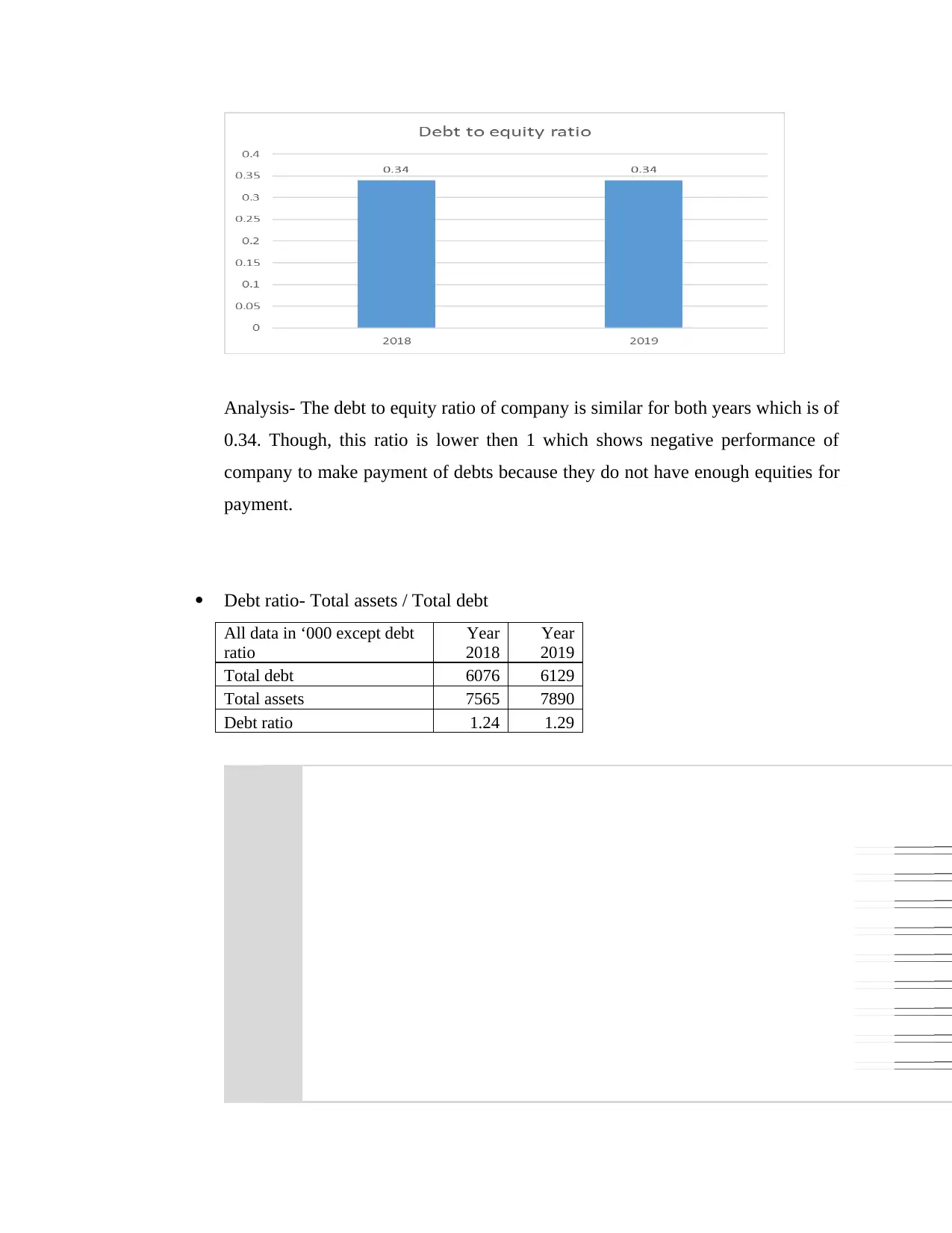
Analysis- The debt to equity ratio of company is similar for both years which is of
0.34. Though, this ratio is lower then 1 which shows negative performance of
company to make payment of debts because they do not have enough equities for
payment.
Debt ratio- Total assets / Total debt
All data in ‘000 except debt
ratio
Year
2018
Year
2019
Total debt 6076 6129
Total assets 7565 7890
Debt ratio 1.24 1.29
0.34. Though, this ratio is lower then 1 which shows negative performance of
company to make payment of debts because they do not have enough equities for
payment.
Debt ratio- Total assets / Total debt
All data in ‘000 except debt
ratio
Year
2018
Year
2019
Total debt 6076 6129
Total assets 7565 7890
Debt ratio 1.24 1.29
⊘ This is a preview!⊘
Do you want full access?
Subscribe today to unlock all pages.

Trusted by 1+ million students worldwide
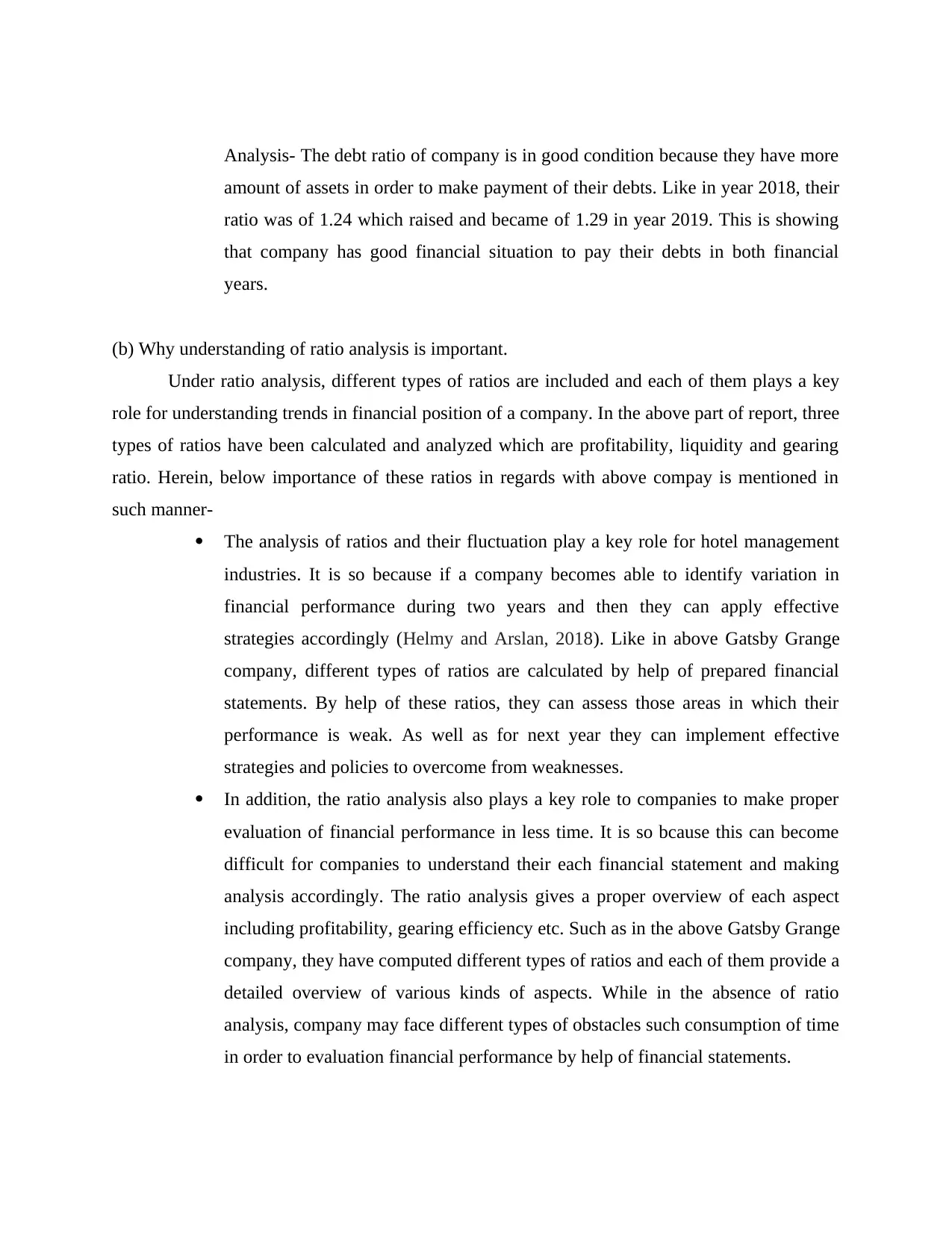
Analysis- The debt ratio of company is in good condition because they have more
amount of assets in order to make payment of their debts. Like in year 2018, their
ratio was of 1.24 which raised and became of 1.29 in year 2019. This is showing
that company has good financial situation to pay their debts in both financial
years.
(b) Why understanding of ratio analysis is important.
Under ratio analysis, different types of ratios are included and each of them plays a key
role for understanding trends in financial position of a company. In the above part of report, three
types of ratios have been calculated and analyzed which are profitability, liquidity and gearing
ratio. Herein, below importance of these ratios in regards with above compay is mentioned in
such manner-
The analysis of ratios and their fluctuation play a key role for hotel management
industries. It is so because if a company becomes able to identify variation in
financial performance during two years and then they can apply effective
strategies accordingly (Helmy and Arslan, 2018). Like in above Gatsby Grange
company, different types of ratios are calculated by help of prepared financial
statements. By help of these ratios, they can assess those areas in which their
performance is weak. As well as for next year they can implement effective
strategies and policies to overcome from weaknesses.
In addition, the ratio analysis also plays a key role to companies to make proper
evaluation of financial performance in less time. It is so bcause this can become
difficult for companies to understand their each financial statement and making
analysis accordingly. The ratio analysis gives a proper overview of each aspect
including profitability, gearing efficiency etc. Such as in the above Gatsby Grange
company, they have computed different types of ratios and each of them provide a
detailed overview of various kinds of aspects. While in the absence of ratio
analysis, company may face different types of obstacles such consumption of time
in order to evaluation financial performance by help of financial statements.
amount of assets in order to make payment of their debts. Like in year 2018, their
ratio was of 1.24 which raised and became of 1.29 in year 2019. This is showing
that company has good financial situation to pay their debts in both financial
years.
(b) Why understanding of ratio analysis is important.
Under ratio analysis, different types of ratios are included and each of them plays a key
role for understanding trends in financial position of a company. In the above part of report, three
types of ratios have been calculated and analyzed which are profitability, liquidity and gearing
ratio. Herein, below importance of these ratios in regards with above compay is mentioned in
such manner-
The analysis of ratios and their fluctuation play a key role for hotel management
industries. It is so because if a company becomes able to identify variation in
financial performance during two years and then they can apply effective
strategies accordingly (Helmy and Arslan, 2018). Like in above Gatsby Grange
company, different types of ratios are calculated by help of prepared financial
statements. By help of these ratios, they can assess those areas in which their
performance is weak. As well as for next year they can implement effective
strategies and policies to overcome from weaknesses.
In addition, the ratio analysis also plays a key role to companies to make proper
evaluation of financial performance in less time. It is so bcause this can become
difficult for companies to understand their each financial statement and making
analysis accordingly. The ratio analysis gives a proper overview of each aspect
including profitability, gearing efficiency etc. Such as in the above Gatsby Grange
company, they have computed different types of ratios and each of them provide a
detailed overview of various kinds of aspects. While in the absence of ratio
analysis, company may face different types of obstacles such consumption of time
in order to evaluation financial performance by help of financial statements.
Paraphrase This Document
Need a fresh take? Get an instant paraphrase of this document with our AI Paraphraser
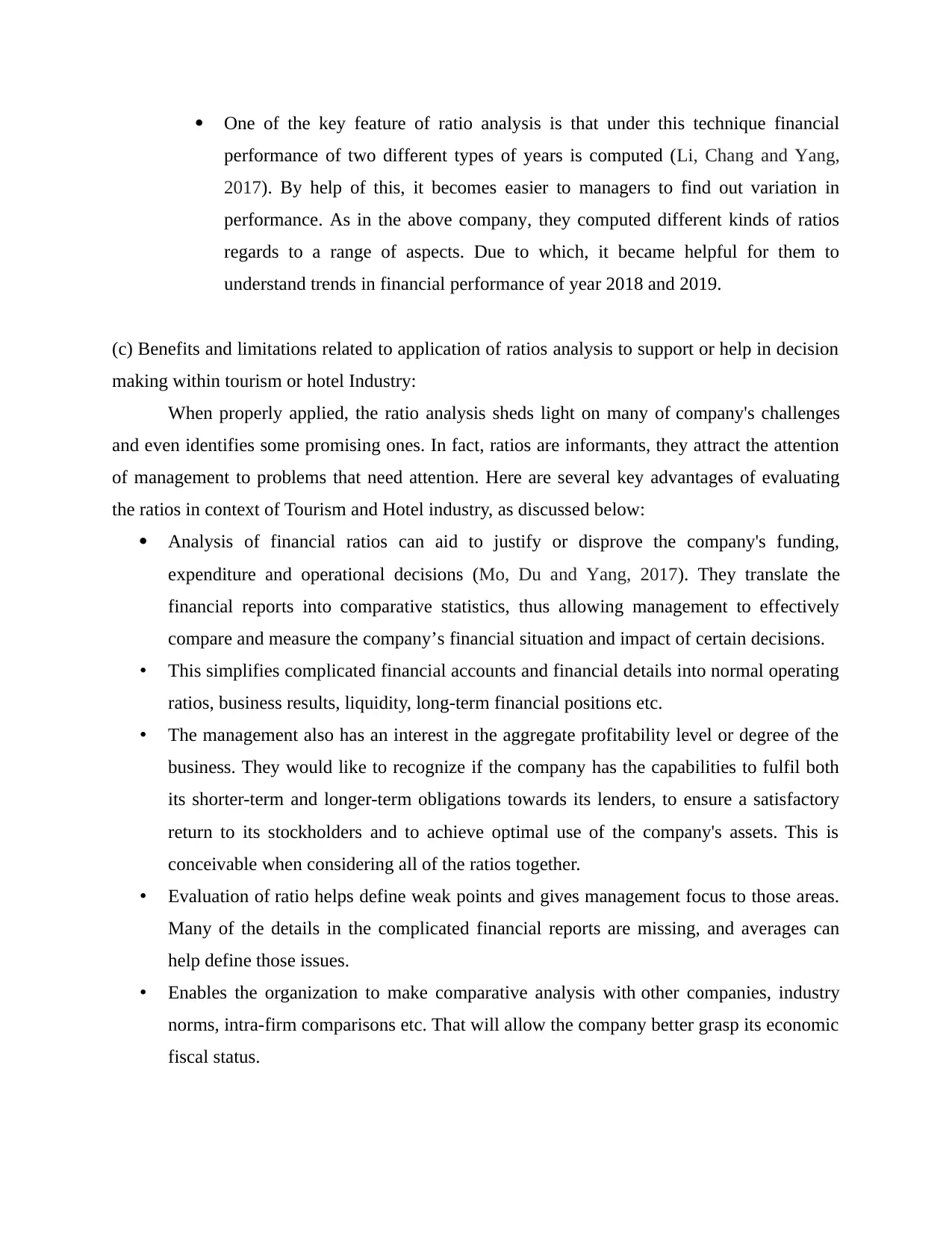
One of the key feature of ratio analysis is that under this technique financial
performance of two different types of years is computed (Li, Chang and Yang,
2017). By help of this, it becomes easier to managers to find out variation in
performance. As in the above company, they computed different kinds of ratios
regards to a range of aspects. Due to which, it became helpful for them to
understand trends in financial performance of year 2018 and 2019.
(c) Benefits and limitations related to application of ratios analysis to support or help in decision
making within tourism or hotel Industry:
When properly applied, the ratio analysis sheds light on many of company's challenges
and even identifies some promising ones. In fact, ratios are informants, they attract the attention
of management to problems that need attention. Here are several key advantages of evaluating
the ratios in context of Tourism and Hotel industry, as discussed below:
Analysis of financial ratios can aid to justify or disprove the company's funding,
expenditure and operational decisions (Mo, Du and Yang, 2017). They translate the
financial reports into comparative statistics, thus allowing management to effectively
compare and measure the company’s financial situation and impact of certain decisions.
• This simplifies complicated financial accounts and financial details into normal operating
ratios, business results, liquidity, long-term financial positions etc.
• The management also has an interest in the aggregate profitability level or degree of the
business. They would like to recognize if the company has the capabilities to fulfil both
its shorter-term and longer-term obligations towards its lenders, to ensure a satisfactory
return to its stockholders and to achieve optimal use of the company's assets. This is
conceivable when considering all of the ratios together.
• Evaluation of ratio helps define weak points and gives management focus to those areas.
Many of the details in the complicated financial reports are missing, and averages can
help define those issues.
• Enables the organization to make comparative analysis with other companies, industry
norms, intra-firm comparisons etc. That will allow the company better grasp its economic
fiscal status.
performance of two different types of years is computed (Li, Chang and Yang,
2017). By help of this, it becomes easier to managers to find out variation in
performance. As in the above company, they computed different kinds of ratios
regards to a range of aspects. Due to which, it became helpful for them to
understand trends in financial performance of year 2018 and 2019.
(c) Benefits and limitations related to application of ratios analysis to support or help in decision
making within tourism or hotel Industry:
When properly applied, the ratio analysis sheds light on many of company's challenges
and even identifies some promising ones. In fact, ratios are informants, they attract the attention
of management to problems that need attention. Here are several key advantages of evaluating
the ratios in context of Tourism and Hotel industry, as discussed below:
Analysis of financial ratios can aid to justify or disprove the company's funding,
expenditure and operational decisions (Mo, Du and Yang, 2017). They translate the
financial reports into comparative statistics, thus allowing management to effectively
compare and measure the company’s financial situation and impact of certain decisions.
• This simplifies complicated financial accounts and financial details into normal operating
ratios, business results, liquidity, long-term financial positions etc.
• The management also has an interest in the aggregate profitability level or degree of the
business. They would like to recognize if the company has the capabilities to fulfil both
its shorter-term and longer-term obligations towards its lenders, to ensure a satisfactory
return to its stockholders and to achieve optimal use of the company's assets. This is
conceivable when considering all of the ratios together.
• Evaluation of ratio helps define weak points and gives management focus to those areas.
Many of the details in the complicated financial reports are missing, and averages can
help define those issues.
• Enables the organization to make comparative analysis with other companies, industry
norms, intra-firm comparisons etc. That will allow the company better grasp its economic
fiscal status.
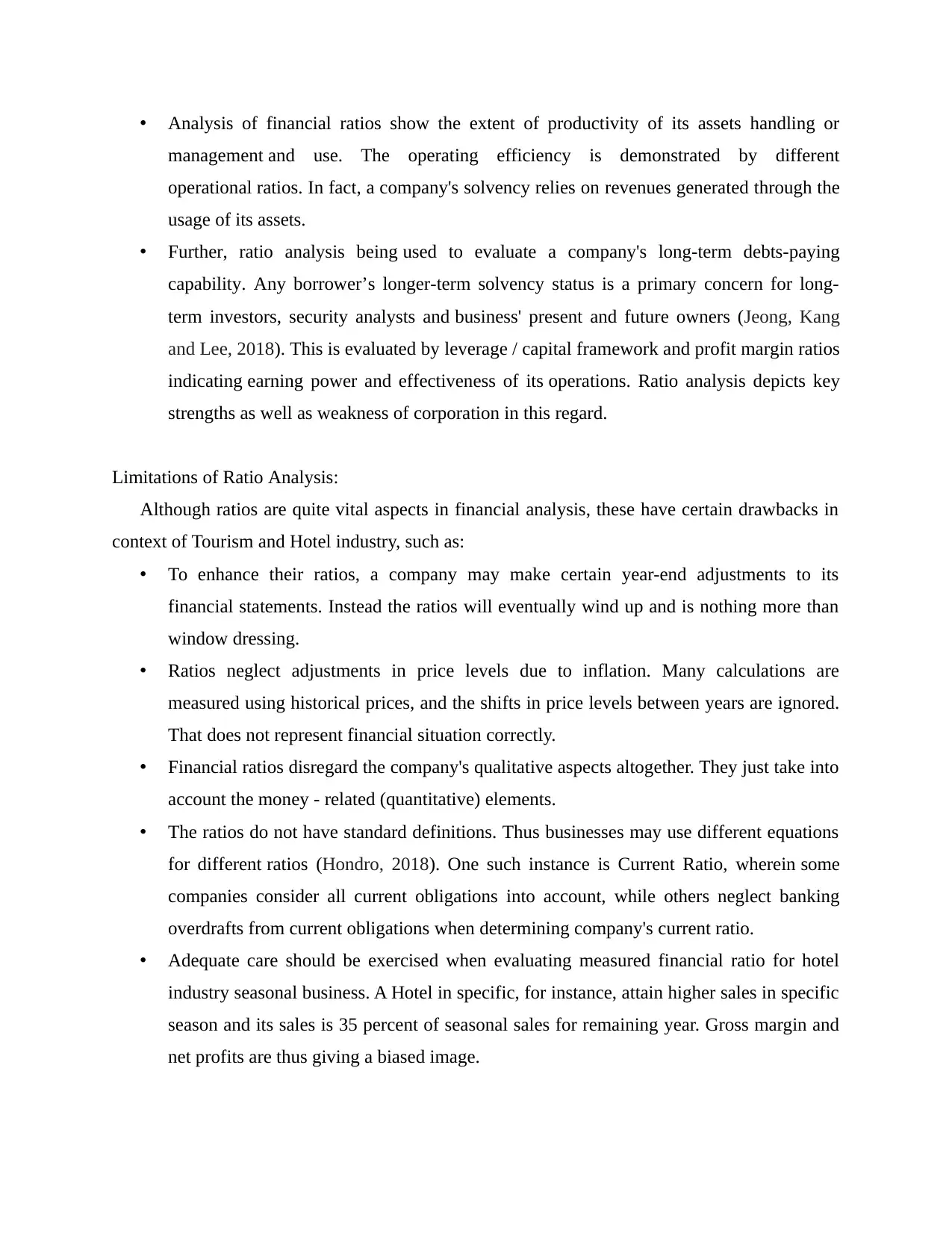
• Analysis of financial ratios show the extent of productivity of its assets handling or
management and use. The operating efficiency is demonstrated by different
operational ratios. In fact, a company's solvency relies on revenues generated through the
usage of its assets.
• Further, ratio analysis being used to evaluate a company's long-term debts-paying
capability. Any borrower’s longer-term solvency status is a primary concern for long-
term investors, security analysts and business' present and future owners (Jeong, Kang
and Lee, 2018). This is evaluated by leverage / capital framework and profit margin ratios
indicating earning power and effectiveness of its operations. Ratio analysis depicts key
strengths as well as weakness of corporation in this regard.
Limitations of Ratio Analysis:
Although ratios are quite vital aspects in financial analysis, these have certain drawbacks in
context of Tourism and Hotel industry, such as:
• To enhance their ratios, a company may make certain year-end adjustments to its
financial statements. Instead the ratios will eventually wind up and is nothing more than
window dressing.
• Ratios neglect adjustments in price levels due to inflation. Many calculations are
measured using historical prices, and the shifts in price levels between years are ignored.
That does not represent financial situation correctly.
• Financial ratios disregard the company's qualitative aspects altogether. They just take into
account the money - related (quantitative) elements.
• The ratios do not have standard definitions. Thus businesses may use different equations
for different ratios (Hondro, 2018). One such instance is Current Ratio, wherein some
companies consider all current obligations into account, while others neglect banking
overdrafts from current obligations when determining company's current ratio.
• Adequate care should be exercised when evaluating measured financial ratio for hotel
industry seasonal business. A Hotel in specific, for instance, attain higher sales in specific
season and its sales is 35 percent of seasonal sales for remaining year. Gross margin and
net profits are thus giving a biased image.
management and use. The operating efficiency is demonstrated by different
operational ratios. In fact, a company's solvency relies on revenues generated through the
usage of its assets.
• Further, ratio analysis being used to evaluate a company's long-term debts-paying
capability. Any borrower’s longer-term solvency status is a primary concern for long-
term investors, security analysts and business' present and future owners (Jeong, Kang
and Lee, 2018). This is evaluated by leverage / capital framework and profit margin ratios
indicating earning power and effectiveness of its operations. Ratio analysis depicts key
strengths as well as weakness of corporation in this regard.
Limitations of Ratio Analysis:
Although ratios are quite vital aspects in financial analysis, these have certain drawbacks in
context of Tourism and Hotel industry, such as:
• To enhance their ratios, a company may make certain year-end adjustments to its
financial statements. Instead the ratios will eventually wind up and is nothing more than
window dressing.
• Ratios neglect adjustments in price levels due to inflation. Many calculations are
measured using historical prices, and the shifts in price levels between years are ignored.
That does not represent financial situation correctly.
• Financial ratios disregard the company's qualitative aspects altogether. They just take into
account the money - related (quantitative) elements.
• The ratios do not have standard definitions. Thus businesses may use different equations
for different ratios (Hondro, 2018). One such instance is Current Ratio, wherein some
companies consider all current obligations into account, while others neglect banking
overdrafts from current obligations when determining company's current ratio.
• Adequate care should be exercised when evaluating measured financial ratio for hotel
industry seasonal business. A Hotel in specific, for instance, attain higher sales in specific
season and its sales is 35 percent of seasonal sales for remaining year. Gross margin and
net profits are thus giving a biased image.
⊘ This is a preview!⊘
Do you want full access?
Subscribe today to unlock all pages.

Trusted by 1+ million students worldwide
1 out of 15
Related Documents
Your All-in-One AI-Powered Toolkit for Academic Success.
+13062052269
info@desklib.com
Available 24*7 on WhatsApp / Email
![[object Object]](/_next/static/media/star-bottom.7253800d.svg)
Unlock your academic potential
Copyright © 2020–2025 A2Z Services. All Rights Reserved. Developed and managed by ZUCOL.





